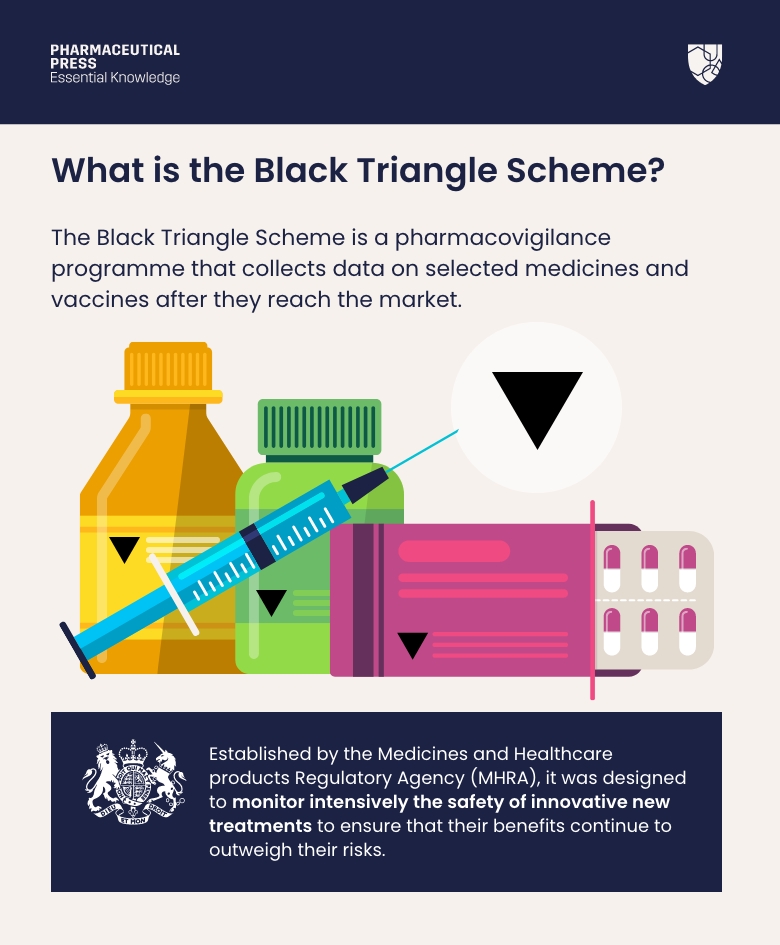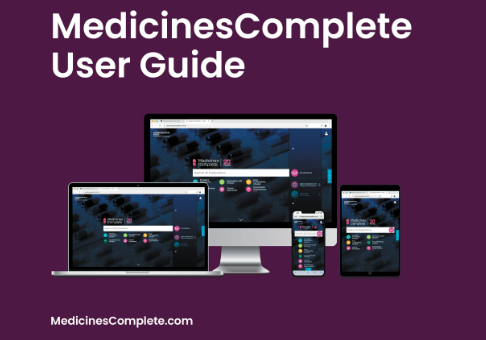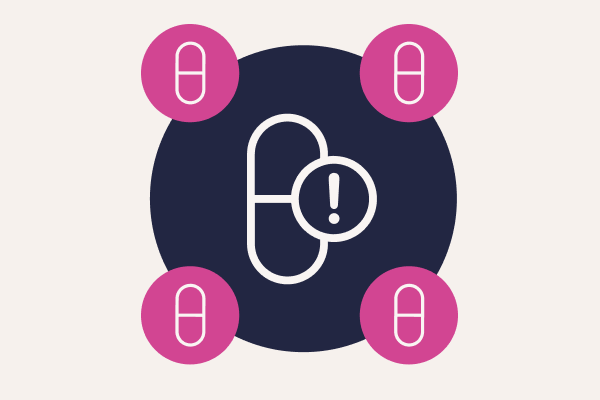What are Black Triangle drugs?
The Black Triangle Scheme is a pharmacovigilance programme that collects data on selected medicines and vaccines after they reach the market. Established by the Medicines and Healthcare products Regulatory Agency (MHRA), it was designed to monitor intensively the safety of innovative new treatments to ensure that their benefits continue to outweigh their risks.

In the UK, it is part of the Yellow Card scheme, which safeguards the quality and efficacy of medicines, vaccines, medical devices, blood products, and e-cigarettes.¹ Through the Yellow Card scheme, the MHRA collects and monitors information on suspected safety concerns involving healthcare products, like side effects caused by a medicine, or adverse incidents involving medical devices.
Please complete the form at the bottom of this article to request a complimentary trial of MedicinesComplete.
For medicines identified by a black triangle symbol (▼), health professionals, as well as patients and the public, are asked to report any suspected adverse drug reaction (ADR), no matter how minor, experienced while using these medicines. The symbol (▼) appears in a number of places, including the prescribing information, all advertising materials, and alongside the product’s “medicinal forms” listings in British National Formulary (BNF), BNF for Children (BNFC) and Nurse Prescribers’ Formulary (NPF), and the patient information leaflet.²
In this article, we will explain what the Black Triangle Scheme is, its purpose, and how it works, as well as what it means for health professionals in practice.
Pharmacovigilance
All new medicines go through a rigorous process of testing and monitoring e.g. clinical trials before securing approval for use in patients. Yet it is important to recognise the limitations of clinical trials. Studies tend to include a relatively small number of patients, who take the medicine for a relatively short time under strict conditions. As such, they usually only identify a treatment’s most common ADRs. Rare or long-term side effects, or unwanted effects that may occur only in people with specific conditions or taking other medicines, are often only revealed when large numbers of people have been exposed to the product.¹
Pharmacovigilance, or the post-marketing monitoring of new medicines, allows regulators to spot and evaluate any ADRs as and when they emerge, and take the appropriate action.³
All medicines need to be monitored after being licensed to ensure they are acceptably safe for patients and users. For medicines and vaccines that have been available for a considerable time, however, the focus is on encouraging the reporting of all serious suspected ADRs, even if the effect is well recognised. For new medicines, closer monitoring for potential side effects is required, because there is limited real-life experience with the product.

What is the purpose of the Black Triangle Scheme?
The primary purpose of the Black Triangle Scheme is to ensure patient safety. The ‘additional monitoring’ of all suspected ADRs experienced while taking these medicines helps regulators build up a better picture of a product’s side effect profile. Regulators can assess the reported effects to ascertain whether or not they may be caused by the treatment. Data collected through the scheme helps bodies, such as the MHRA, decide if any changes to the medication’s approval are necessary. Such changes may include updates to the detailed prescribing information, such as cautions, contra-indications, side effects etc., or, in rare cases, withdrawal of the product from the market.¹
Products that are subject to additional monitoring are clearly marked with the black triangle (▼). This does not mean that the medicine or vaccine is unsafe, rather that regulators are still closely observing its effects.
This enhanced approach to surveillance encourages health professionals and patients to be vigilant, allowing for the early identification of any previously unknown side effects. In addition, health professionals are supported to make informed prescribing decisions, for example when considering whether a newer medicine is the most appropriate for a given patient.
How does the Black Triangle Scheme work?
New active substances, biosimilar medicines, new combinations of medicines or active substances, as well as agents with a new route of administration or drug-delivery system, all fall within the remit of the Black Triangle Scheme. It can also apply to established medicines being used in a new indication or different patient population than for which they were first approved. Such products are denoted with an asterisk next to the black triangle symbol (▼*).²
Mavacamten, a novel therapy for hypertrophic cardiomyopathy (HCM), is an example of a Black Triangle medicine (as of November 2024). Approved for use in the UK in September 2023, it has a novel mechanism of action, in that in it modulates cardiac myosin to reduce hypercontractility.⁶ At the time of authorisation, it was the first medicine to slow disease progression by targeting the abnormal heart function that causes HCM, rather than simply treating the symptoms. However, it is the first in this new class of medicine to be marketed, so the number of people who have taken it so far is relatively limited.
The COVID-19 vaccines Nuvaxovid, Spikevax, and Comirnaty also carry a black triangle symbol, as they are all novel products.⁷ In addition, Spikevax and Comirnaty were the first messenger RNA (mRNA) vaccines to secure approval for use in humans, despite the approach having been studied for decades.⁸ As such regulators have a particular interest in monitoring their use in wide patient populations.
With the additional monitoring requirements in place for such medicines, regulators will have a larger dataset of reported side effects in a wide range of patients to evaluate. Ultimately this helps ensure eligible patients have early access to new drugs and vaccines, while data on their safety and effectiveness are collected.
The Black Triangle scheme has been in operation for many years in the UK, but it became a European Union-wide programme in 2013.⁴ ⁹ Since then, all medicines involved have been included on a regularly updated, centralised list.⁴ Health professionals are made aware of a treatment’s Black Triangle status in a number of ways, including via MHRA Drug Safety Updates and prescribing information in the electronic medicines compendium. The symbol also appears on all advertising materials, and product entries in BNF, BNFC and NPF.¹ To check if product has a Black Triangle, health professionals can search for the medicine or vaccine in BNF, BNFC or NPF, and navigate to the “medicinal forms” section.
Reporting for Black Triangle products
Health professionals, patients and the public, are asked to report all potential side effects a patient experiences while using a Black Triangle product to the Yellow Card scheme, no matter how minor the reaction seems.
Reports should include four critical pieces of information – the suspect drug(s), the suspected reaction(s), a patient identifier, and the reporter’s details – along with as much supplementary information as possible.¹⁰
The MHRA provides the following guidance on how to make a Yellow Card report:¹⁰
1) State the suspect drug or drugs. It is also helpful, if possible, to include the route of administration, the daily dose, dose frequency and schedule, and the date or dates of administration. Where the report relates to a vaccine, reporters should include the brand name and batch number, if they have this information
2) State the suspected reaction or reactions. It is also helpful to include when the reaction occurred in relation to taking the medicine and its severity, as well as any treatment given for the symptoms and the outcome
3) Include non-identifying patient details. Reports should include the patient’s sex and/or age at the time of the reaction, along with, if known, their weight. The patient’s initials and a local identification number, such as a hospital or practice reference number, can help health professionals to identify them in any future correspondence
4) Include the reporter details: The reporter should include their name and contact details, so the MHRA can acknowledge receipt of the report and follow up for further information if necessary.
Where possible, reporters should also include:¹⁰
• any other medicines the patient has taken in the three months prior to the reaction, including over-the-counter and herbal medicines
• where relevant, any information on what happened if the suspect drug was re-introduced
• any relevant medical history, such as allergies
• any relevant test results
• where the report is associated with congenital abnormalities, the MHRA asks reporters to list all other drugs taken during the pregnancy, as well as the date of the mother’s last menstrual period.
The MHRA also recommends health professionals keep a copy of the Yellow Card report in the patient’s notes for future reference.¹⁰
Health professionals can complete this form and either send it by post, using the address FREEPOST YELLOW CARD, or email yellowcard@mhra.gov.uk Once the report has been received, the reporter will receive a Yellow Card registration number.
How the MHRA identifies potential safety issues
The MHRA uses specialist data analytics software to identify potential safety issues. All Yellow Card reports are collated in a database, and subject to review and statistical analysis of all drug reaction combinations. This identifies ‘signals’, or drug-reaction combinations that occur more frequently than would be expected when compared to the background frequency of other drug-reaction combinations in the database.¹¹
A team of safety experts investigates all signals that meet a predefined criteria. Using the Yellow Card data and other sources, such as case reports in the literature, information from pharmaceutical companies, pre- and post-marketing clinical trials, epidemiological studies, and data from other regulatory authorities, the team attempts to quantify the risks and assess the likelihood of a causal relationship between the drugs and the reported reactions. The results inform the MHRA’s decision on how best to act in order to protect public health.¹¹
Black Triangle Scheme duration
The MHRA reviews the Black Triangle status of a product after it has been on the market for two years,² and this is usually retained for five years.¹² However, the symbol is not removed until the safety of the drug is well established.
Conclusion
The Black Triangle Scheme is a crucial element of pharmacovigilance, enhancing the safety monitoring of newly licensed medicines and vaccines that have more limited data to support their safety. It supports the comprehensive data collection that is essential for assessing the safety and effectiveness of new or novel products in real-world settings – ensuring people can access innovative treatments while minimising risk. The initiative not only facilitates the early identification of previously unknown side effects, but also empowers health professionals to make informed prescribing decisions.
Trial form
Please complete the form below to request a complimentary trial to knowledge products through MedicinesComplete.
References
1. Gov.uk. (2021). The Yellow Card scheme: guidance for healthcare professionals, patients and the public. Available at: https://www.gov.uk/guidance/the-yellow-card-scheme-guidance-for-healthcare-professionals Last accessed: 26 November 2024
2. Gov.uk. (2014). The Black Triangle Scheme (▼ or ▼*). Available at: https://www.gov.uk/drug-safety-update/the-black-triangle-scheme-or Last accessed: 26 November 2024
3. WHO. (n.d.) Regulation and Prequalification. Available at: https://www.who.int/teams/regulation-prequalification/regulation-and-safety/pharmacovigilance Last accessed: 26 November 2024
4. EMA. (n.d.) Medicines under additional monitoring. Available at: https://www.ema.europa.eu/en/human-regulatory-overview/post-authorisation/pharmacovigilance-post-authorisation/medicines-under-additional-monitoring Last accessed: 26 November 2024
5. BNF. (n.d.) Mavacamten: Medicinal forms. Available at: https://bnf.nice.org.uk/drugs/mavacamten/medicinal-forms/ Last accessed: 26 November 2024
6. NICE. (2023). Mavacamten for treating symptomatic obstructive hypertrophic cardiomyopathy. Available at: https://www.nice.org.uk/guidance/ta913 Last accessed: 26 November 2024
7. BNF. (n.d.) COVID-19 vaccine: Medicinal forms. Available at: https://bnf.nice.org.uk/drugs/covid-19-vaccine/medicinal-forms/ Last accessed: 26 November 2024
8. Park J W, Lagniton, P, et al. (2021). mRNA vaccines for COVID-19: What, Why And How. International Journal Of Biological Sciences. 17(6), 1446
9. MHRA. (n.d.). Black Triangle Scheme – new medicines and vaccines subject to EU-wide additional monitoring. Available at: https://assets.publishing.service.gov.uk/media/5a7d5eeae5274a02dcdf419f/Black_Triangle_Scheme_-_new_medicines_and_vaccines_subject_to_EU-wide_additional_monitoring.pdf Last accessed: 26 November 2024
10. MHRA. (n.d.). What To Include In Your Yellow Card Of An Adverse Drug Reaction. Available at: https://assets.publishing.service.gov.uk/media/5a81b671e5274a2e87dbf1c1/What_to_include_in_your_Yellow_Card_of_an_adverse_drug_reaction.pdf Last accessed: 26 November 2024
11. MHRA. (n.d.). Pharmacovigilance – How the MHRA Monitors the Safety of Medicines. Available at: https://assets.publishing.service.gov.uk/media/5feefb56d3bf7f089a791a2c/Pharmacovigilance___how_the_MHRA_monitors_the_safety_of_medicines.pdf Last accessed: 26 November 2024
12. BNF. (n.d.). Adverse Reactions to Drugs. Available at: https://bnf.nice.org.uk/medicines-guidance/adverse-reactions-to-drugs/ Last accessed: 26 November 2024







